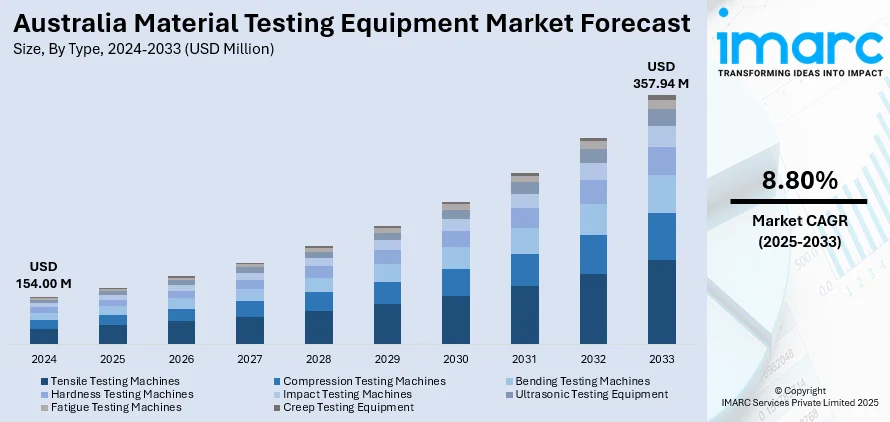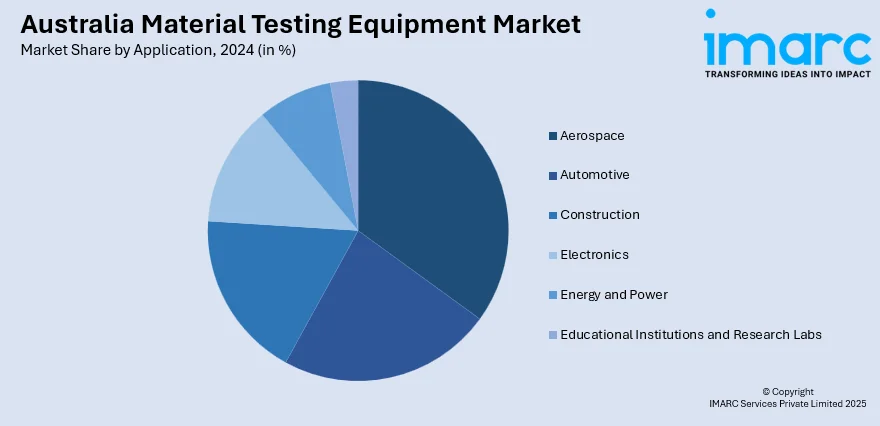
Australia Material Testing Equipment Market Size, Share, Trends and Forecast by Type, Application, End User, and Region, 2025-2033
Australia Material Testing Equipment Market Size and Share:
The Australia material testing equipment market size reached USD 154.00 Million in 2024. Looking forward, IMARC Group expects the market to reach USD 357.94 Million by 2033, exhibiting a growth rate (CAGR) of 8.80% during 2025-2033. The market is driven by infrastructure-led construction mandates that enforce rigorous material validation protocols across urban and transport projects. Mining and resource sectors require precise and compliant testing to support export-grade quality assurance, especially in metals and minerals, thereby fueling the market. Rapid innovation in manufacturing and product safety obligations further accelerate the need for advanced testing solutions, strengthening the Australia material testing equipment market share.
|
Report Attribute
|
Key Statistics
|
|---|---|
|
Base Year
|
2024 |
|
Forecast Years
|
2025-2033
|
|
Historical Years
|
2019-2024
|
| Market Size in 2024 | USD 154.00 Million |
| Market Forecast in 2033 | USD 357.94 Million |
| Market Growth Rate 2025-2033 | 8.80% |
Australia Material Testing Equipment Market Trends:
Infrastructure Projects and Construction Sector Compliance
Australia’s substantial investment in infrastructure across transport, defense, and public utilities has created consistent demand for rigorous material quality assessment. On May 30, 2025, the Australian Bureau of Statistics reported a positive trend in the building approvals sector, with a 14.7% increase in the value of non-residential building approvals in April 2025. Additionally, Western Australia and South Australia saw notable increases in total dwelling approvals, rising by 9.6% and 9.5%, respectively. Bridges, tunnels, rail systems, and ports require testing of concrete, asphalt, aggregates, and soil to meet Australian Standards (AS) and National Construction Code (NCC) compliance. Contractors and engineers are adopting universal testing machines, hardness testers, and compression equipment to ensure strength, durability, and safety in construction inputs. Frequent quality audits and certification mandates by state-level infrastructure agencies have institutionalized material testing as an indispensable part of project planning and execution. Additionally, major urban development initiatives in Sydney, Brisbane, and Melbourne have generated demand for portable and high-throughput equipment suited to dynamic site conditions. Laboratories are scaling up automation and real-time reporting to meet tighter delivery schedules. Increased emphasis on long-term structural integrity, especially in transport infrastructure and high-rise buildings, drives the use of advanced testing technologies from procurement through to final inspection. This regulatory integration and sector-wide standardization are reinforcing demand across both public and private infrastructure stakeholders, driving Australia material testing equipment market growth.

To get more information on this market, Request Sample
Manufacturing and Product Safety Compliance
Australia’s highly regulated manufacturing sector, covering aerospace, automotive, defense, and consumer goods, mandates stringent testing of raw materials and finished components to ensure compliance with product safety standards. Whether testing the fatigue of aircraft-grade aluminum, verifying weld quality in defense manufacturing, or assessing plastic polymer properties in packaging, producers are dependent on accurate, consistent testing outputs. The emergence of additive manufacturing and composites in industrial design has introduced new variables, driving demand for customized testing instruments that can assess novel material behaviors. For instance, on April 10, 2025, RMIT University announced a breakthrough in bio-oil production technology, PYROCOTM, which uses high temperatures without oxygen to convert biosolids into biochar, a sustainable catalyst for phenol-rich bio-oils. The project has secured a funding partnership, including AUD 3 million (USD 1.9 million) from the Australian Government, to build a commercial-scale demonstration plant. As the bio-oil and biochar production process advances, material testing equipment will be crucial for ensuring the quality, consistency, and safety of these new materials in industrial applications. Additionally, ISO certifications and Australian regulatory standards (e.g., AS/NZS) require validation of material integrity under stress, temperature, and mechanical deformation. Manufacturers serving international markets further adhere to ASTM, EN, and JIS testing frameworks, demanding equipment capable of multi-standard compliance. Digital integration and automated reporting are now expected in test environments to minimize manual error and support traceable results. These expectations are accelerating the procurement of multifunctional testing systems capable of simulating real-world performance conditions. As product design becomes more complex and regulatory obligations tighten, manufacturers view advanced material testing as fundamental to operational reliability and brand credibility.
Australia Material Testing Equipment Market Segmentation:
IMARC Group provides an analysis of the key trends in each segment of the market, along with forecasts at the country and regional levels for 2025-2033. Our report has categorized the market based on type, application, and end user.
Type Insights:
- Tensile Testing Machines
- Compression Testing Machines
- Bending Testing Machines
- Hardness Testing Machines
- Impact Testing Machines
- Ultrasonic Testing Equipment
- Fatigue Testing Machines
- Creep Testing Equipment
The report has provided a detailed breakup and analysis of the market based on the type. This includes tensile testing machines, compression testing machines, bending testing machines, hardness testing machines, impact testing machines, ultrasonic testing equipment, fatigue testing machines, and creep testing equipment.
Application Insights:

- Aerospace
- Automotive
- Construction
- Electronics
- Energy and Power
- Educational Institutions and Research Labs
The report has provided a detailed breakup and analysis of the market based on the application. This includes aerospace, automotive, construction, electronics, energy and power, and educational institutions and research labs.
End User Insights:
- Manufacturers
- Research and Development Laboratories
- Quality Control and Assurance Departments
- Academic Institutions
- Governmental Regulatory Bodies
The report has provided a detailed breakup and analysis of the market based on the end user. This includes manufacturers, research and development laboratories, quality control and assurance departments, academic institutions, and governmental regulatory bodies.
Regional Insights:
- Australia Capital Territory & New South Wales
- Victoria & Tasmania
- Queensland
- Northern Territory & Southern Australia
- Western Australia
The report has also provided a comprehensive analysis of all major regional markets. This includes Australia Capital Territory & New South Wales, Victoria & Tasmania, Queensland, Northern Territory & Southern Australia, and Western Australia.
Competitive Landscape:
The market research report has also provided a comprehensive analysis of the competitive landscape. Competitive analysis such as market structure, key player positioning, top winning strategies, competitive dashboard, and company evaluation quadrant has been covered in the report. Also, detailed profiles of all major companies have been provided.
Australia Material Testing Equipment Market News:
- On February 25, 2025, Edith Cowan University (ECU) and Fraunhofer IKTS announced the establishment of Western Australia’s first research and innovation lab, focusing on sustainable ceramic technologies for industrial water treatment, hydrogen generation, and non-destructive testing. The collaboration will address critical areas such as circular water management, efficient hydrogen production, and advanced testing for industries like mining and oil & gas.
Australia Material Testing Equipment Market Report Coverage:
| Report Features | Details |
|---|---|
| Base Year of the Analysis | 2024 |
| Historical Period | 2019-2024 |
| Forecast Period | 2025-2033 |
| Units | Million USD |
| Scope of the Report |
Exploration of Historical Trends and Market Outlook, Industry Catalysts and Challenges, Segment-Wise Historical and Future Market Assessment:
|
| Types Covered | Tensile Testing Machines, Compression Testing Machines, Bending Testing Machines, Hardness Testing Machines, Impact Testing Machines, Ultrasonic Testing Equipment, Fatigue Testing Machines, Creep Testing Equipment |
| Applications Covered | Aerospace, Automotive, Construction, Electronics, Energy and Power, Educational Institutions and Research Labs |
| End Users Covered | Manufacturers, Research and Development Laboratories, Quality Control and Assurance Departments, Academic Institutions, Governmental Regulatory Bodies |
| Regions Covered | Australia Capital Territory & New South Wales, Victoria & Tasmania, Queensland, Northern Territory & Southern Australia, Western Australia |
| Customization Scope | 10% Free Customization |
| Post-Sale Analyst Support | 10-12 Weeks |
| Delivery Format | PDF and Excel through Email (We can also provide the editable version of the report in PPT/Word format on special request) |
Key Questions Answered in This Report:
- How has the Australia material testing equipment market performed so far and how will it perform in the coming years?
- What is the breakup of the Australia material testing equipment market on the basis of type?
- What is the breakup of the Australia material testing equipment market on the basis of application?
- What is the breakup of the Australia material testing equipment market on the basis of end user?
- What is the breakup of the Australia material testing equipment market on the basis of region?
- What are the various stages in the value chain of the Australia material testing equipment market?
- What are the key driving factors and challenges in the Australia material testing equipment market?
- What is the structure of the Australia material testing equipment market and who are the key players?
- What is the degree of competition in the Australia material testing equipment market?
Key Benefits for Stakeholders:
- IMARC’s industry report offers a comprehensive quantitative analysis of various market segments, historical and current market trends, market forecasts, and dynamics of the Australia material testing equipment market from 2019-2033.
- The research report provides the latest information on the market drivers, challenges, and opportunities in the Australia material testing equipment market.
- Porter's five forces analysis assist stakeholders in assessing the impact of new entrants, competitive rivalry, supplier power, buyer power, and the threat of substitution. It helps stakeholders to analyze the level of competition within the Australia material testing equipment industry and its attractiveness.
- Competitive landscape allows stakeholders to understand their competitive environment and provides an insight into the current positions of key players in the market.
Need more help?
- Speak to our experienced analysts for insights on the current market scenarios.
- Include additional segments and countries to customize the report as per your requirement.
- Gain an unparalleled competitive advantage in your domain by understanding how to utilize the report and positively impacting your operations and revenue.
- For further assistance, please connect with our analysts.
 Request Customization
Request Customization
 Speak to an Analyst
Speak to an Analyst
 Request Brochure
Request Brochure
 Inquire Before Buying
Inquire Before Buying




.webp)




.webp)












